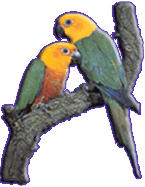|
|
| |
|
|
|
|
MAROON-BELLIED PARAKEET
Braunohrsttich Pyrrhura Frontalis
|
|
|
| |
Natural habitat of these parrot species are countries of southern America , especially forests of Brazil , Uruguay , Paraguay , Bolivia and Argentina . With its 26cm Maroon-bellied parakeet is middle length parrot. Beside basic species, there are two subspecies: Bolivian maroon-bellied parakeet and Paraguayan Maroon-belled parakeet. The difference between these two subspecies and the basic one is in the color of the breasts, back and tail. Basic color of maroon-bellied parakeet is shiny greenish-olive, while the breasts are more like chestnut color. The forehead is also brown, but it turns to black near the beak. Above the cere, there are several red feathers. Ear coverts are grayish-brown. In some languages the ear coverts color was crucial for their name. Feathers on the both side of the neck, throat and breasts are green with a bit of yellowish-brown, outlined with olive colored stripes. The length of the wing is 13-14cm outlined with green, primaries are bluish-green outlined with blue and on the very end, they turn to green. Under wing, coverts are grey. Upper tail coverts are emerald-green, under tail coverts and the very end of the tail is brownish-red that is best seen while the bird is in flight. Iris is dark brown, and the rings around the eyes are white just like the cere is.
|
| |
|
|
No matter its size, this bird has black powerful beak sized 2cm, which is quite normal for all South American parrots. Legs are grey, with dark claws. Difference between female and mail is in size. Females are a bit smaller and have thinner forehead line; also, females have smaller red mark on the belly. Genetically mutation is only in blue. Outside the nesting season, which starts in early spring, they live in flocks. They fed on seedish food, and the South American jungle vegetation gives them wide assortment of seeds and fruits. Formed couples, once when make nest, aggressively defend it from any intruders, no matter the size or the bird species. The female lays 3 to 5 eggs in the hollow of the tree. Incubation period lasts for 21 to 22 days. After the hatching out, chicks stay in the nest for 4 to 5 weeks, until they are fully feathered. After they are fully feathered, they go on their first flight, but still do not leave the parents for another month, and in that period they learn to consume the food and practice flying skills. When they leave the nest and their parents, young birds make new flocks and start living on their own. |
|
| |
|
|
| |
|
|
They have good health and are quite resistant to illnesses, they can also live on low temperatures. As pets, Maroon-bellied parakeets are very easy and undemanding. They can learn to mimic quite a number of words, even if they are kept in pair. They are very curious and friendly. Soon after the first time out of the cage, your head or shoulder will become it's favourite place. Unfortunatly, this species is not as common as it deserves to be, nevertheless they are very atractive. For some reason, and I don't know what that reason is, whole Pyrrhura family is disregarded, but I honestly belive that this representation shows what a great birds they are. |
|
|
In captivity they fed on sunflower, oat, proso, hemp, sorghum, sometimes enriched with unpeeled nonroasted peanuts. They are very fond of dried fruits and resh greens, but cabbage family vegetables (kail, cauliflower, cabbage) and peer should be avoided, becouse this kind of food is the main cause of diarrhea. Minerals and vitamins are required. From time to time you can treat them wit cookeis like ''Petit Beurre'' or „Plazma“. |
|
|
| |
| |
|
|
|
| |
|
|
|
|

